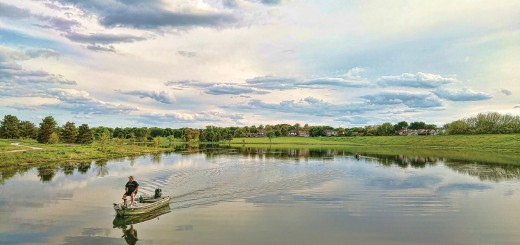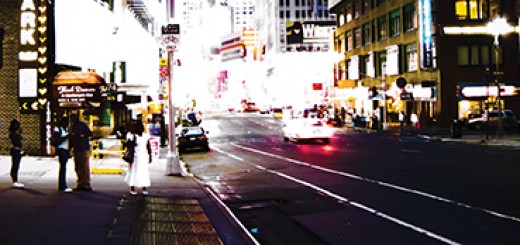Public art abounds in Lincoln

by Sriyani Tidball
Walking around Lincoln, one is reminded that the city is full of wonderful art we can all enjoy. Art in the city goes back more than a century, when in 1912 Nebraska’s great orator William Jennings Bryan spoke to a crowd of thousands at the dedication of the bronze statue of Standing Lincoln. This masterpiece, created by Daniel Chester French, was constructed using public and private funds. French, one of America’s leading sculptors collaborated with architect Henry Bacon, providing the perfect setting at the entrance to the state Capitol with the Gettysburg Address carved into the granite backdrop and Lincoln depicted as just having finished that memorable speech. The statue sits at the west entrance of the Capitol and is the only structure on the grounds that predates the building itself.
A stunning new piece in the city is the Chief Standing Bear sculpture, which is a part of a $9.6 million redesign of Lincoln’s Centennial Mall that runs north from the Capitol building. Sculptor Ben Victor set the bar high as he wanted his 11-foot bronze sculpture of Standing Bear, the Ponca chief whose 1879 trial established that Native Americans are “persons within the meaning of the law,” to be at the same level of artistic beauty as French’s Standing Lincoln.
Ascent, another recent sculpture, was installed at 14th and P streets by German steel and glass workers in the heart of downtown Lincoln. The large glass spire lights up at night like a magical tower of color. Created by renowned Japanese sculptor and Omaha resident Jun Kaneko, it consists of sand gardens and concrete concentric circles that surround the five-story, multi-colored tower. The $1.15 million, 57-foot-tall glass tower, fabricated in Germany, is the centerpiece of Tower Square at 13th and P streets.
A 45-foot-tall metal sculpture, The Harvest, with its ever-changing colors, shines in the plaza in front of Pinnacle Bank Arena in the Haymarket. The abstract sculpture with interior and exterior lights illuminating upward was designed by Portland, OR, artist, Ed Carpenter. The Harvest evokes a sheaf of wheat, or a fountain. All the materials are sensitive to light, and its illumination gives it a 24-hour presence. The dichroic glass used by Carpenter “reacts in a marvelously mercurial way to light,” as the colors change from every angle.
Groundwater Colossus, a giant brick head, at Union Plaza Park at 21st and Q streets, consists of more than 300 individually shaped bricks made of more than 10 tons of red clay and stacked in concentric circles, layer upon layer. The masterpiece stands in the middle block of Union Plaza, between P and Q Streets, and was created by New York City sculpture artist James Tyler.
The Sheldon Sculpture Garden, on the University of Nebraska-Lincoln City Campus, features 30 distinct sculptures from the early 20th century to the present. Dedicated in 1970, the garden originally covered 2.5 acres. Outstanding pieces of modern and contemporary sculptures have been installed in the garden, as well as across the campus. These world-class sculptures created by artists from around the world continually intrigue UNL students and staff as well as visitors to Lincoln. The most popular sculptures in the garden include Torn Notebook by Claes Oldenberg and Coosje van Bruggen, Old Glory by Mark di Suvero and Greenpoint by Richard Serra. For a map of the sculptures and for more information, visit sheldonartmuseum.org. Other sculptures on campus include David Smith’s Superstructure Four, an amazing stainless steel work; Tony Smith’s Willy; Prismatic Flake near the Alumni Building on R Street; and Variable Wedge, an abstract close to Westbrook Music Building.
Eddie Dominguez, an associate professor of art at the University of Nebraska-Lincoln, envisioned Redwall as a collection of 383 individual ceramic tiles that nearly covers an entire wall in the Lied Center for Performing Arts’ newly added Lied Commons. To show that the work represents a community, not a singular artist, individuals who created the tiles remain anonymous. Children and students created many of the tiles with images ranging from flowers to footballs.
A 15-foot tall photomural by Lincoln artist Larry Roots covers the skywalk spanning South 12th Street between O and N streets. Featuring individuals of different age, gender and ethnicities, the mural emphasizes Lincoln’s diversity.
In 2004, the Friends of the Center for Great Plains Studies at the University of Nebraska-Lincoln commissioned sculptor George Lundeen to create a multi-figure sculpture, On the Trail of Discovery: Commemorating the Journey of Lewis and Clark, 1804-1806. The bronze sculpture features explorers Lewis and Clark, a Native American guide and boy, and the expedition’s Newfoundland dog. It commemorates a pivotal moment in American history and guides visitors into UNL’s Center for Great Plains Studies.
Appropriately situated near Nebraska Wesleyan University’s fine arts buildings, Calling Away symbolizes the uniting of the fine arts: art, music, and theater. Calling Away was created by sculptor Dan Peragine and is made of blue welded steel.
One of everyone’s favorite sculptures in Lincoln is the bronze Watchful Citizen portraying a man sitting on one side of a bench with plenty of room for passersby to stop and rest next to him. The sculpture in Lincoln’s Haymarket near Lincoln Station at Seventh and Q streets is a popular spot for photo opportunities. Artists Elizabeth Stanley Wallace and William Schlaebitz created the sculpture in 1993.
Located in one of Lincoln’s most popular attractions, the Sunken Gardens, Reveille is a cast metal sculpture created by Dr. Wayne Southwick. Reveille depicts an angel blowing a trumpet and was inspired by the artist’s wife getting their children out of bed.
The Bicentennial Cascade Fountain is a concrete water feature near one of Lincoln’s busiest intersections at 27th Street and Capitol Parkway. The fountain, created by artist Larry B. Group, is a tribute to teachers and how they influence the youth of Nebraska.
Honoring the pioneer women of Nebraska, sculptor Ellis L. Burman’s Pioneer Woman rests in the Memory Garden at 33rd and Melrose.
Pioneers Park on the southwest edge of Lincoln has a number of amazing sculptures in the midst of nature. Take a walk on the wild side and enjoy the bronzes placed all over the 668 acres of tall-grass prairie, woodlands, wetlands and streams. Enjoy the eight miles of hiking trails that wind through various habitats, sharing amazing art along the way. One of my favorites is The Smoke Signal by Ellis Burman, installed 80 years ago. The piece memorializes Nebraska Native American tribes. Its dedication in 1935 was attended by more than 100 Natives, including chiefs from the Omaha, Winnebago, Sioux, and Ponca tribes who in full dress sat on their horses atop the hillside facing the setting sun.
In 2003, the Lincoln Arts Council spearheaded what is considered Lincoln’s first major public art project. Designed to draw attention to Lincoln’s 85-mile trail system, the Tour de Lincoln featured 71 bicycle sculptures located throughout the city’s parks, businesses, private residences, and, of course, bike trails. In October 2003, the bicycles were auctioned as a fundraiser, although many remain on permanent display in their original locations.
This was followed by 69 pieces of star-themed artwork that graced Lincoln during 2006. This project, which benefited the Lincoln YWCA and each work’s artist, featured work ranging from photographs to sculptures, mosaics to paintings. Each piece was created with a general theme of stars in honor of Lincoln, the Star City.
In 2017, the 89 hearts created for Nebraska Heart were displayed on Haymarket Park’s covered concourse and auctioned. And in 2018, the Serving Hands public art project offered 39 pieces of art around the city. Serving Hands celebrated the 50th anniversary of Campus Life.
These are only a few of the public sculptures in Lincoln, as well as some great murals on walls. The museums are full of amazing art, too. Take time to read the art gallery story on page 59 for more information about all the art that enhances the city. For exact locations of these amazing pieces, check publicart.artscene.org.














Recent Comments